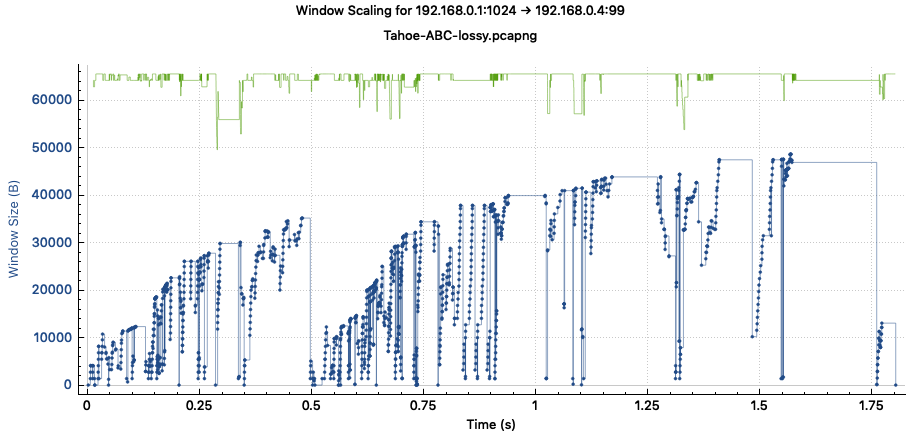Window scaling plots for transmission of 1 MB file over a lossy connection
Without TCP Tahoe enabled

With TCP Tahoe

Stevens curves for transmission of a 1 MB file over a lossy connection
Without TCP Tahoe enabled

With TCP Tahoe

Discussion
As shown in the window scaling plots, when TCP Tahoe congestion control is applied, the maximum number of bytes in flight (the “high point” of the blue curve at each time step) increases linearly-both at the beginning of the connection and after retransmissions (due to Slow Start)-and then increases at a slowing rate after that initial phase (due to Congestion Avoidance once cwnd is greater than ssthresh).
In comparison, when no congestion control is applied, the number of bytes in flight frequently reaches the maximum window size (which is 2^16 - 1, equal to 65535), and also often falls to 0 (likely because the sender is waiting for new bytes to be added to the send buffer).
When Tahoe congestion control is applied, the Stevens sequence number plot has fewer vertical “jumps” than the plot for the connection without congestion control. Each “jump” indicates transmision of a packet with a lower sequence number than the previously-transmitted packet (i.e. packet retransmission) which suggests that the sender and/or receiver is overwhelmed with data and/or has a lossy connection.
Less frequent retransmission, as well as less time between retransmitting a packet and transmisison of the next new packet, are both consistent with congestion control, since:
-
Slow Start and Congestion Avoidance both make it less likely that the rate of data transmission overwhelms the receiver, and should therefore decrease the number of packets dropped.
-
Fast Retransmit / Fast Recovery should decrease the time that the receiver waits for a retransmission, and therefore allow the sender to send the next packet of new data sooner (because the retransmitted packet will be ACK’d sooner and increment the window forward).
Overall, when Tahoe congestion control is applied, data transmission is “smoother” (i.e. the number of bytes in flight changes less erratically).
Even so, the total transmission time for a 1 MB sendfile was longer with congestion control applied, likely because the average congestion-controlled packet size is smaller. Therefore, even though congestion control provides a more “consistent” data stream, for our implementation, that “slow and steady” approach loses the race.
In a network with more traffic (such as a scenario where multiple nodes send large files simultaneously), congestion control could make transmission faster, because the lower rate of packet retransmission could be more significant than the effect of a smaller average packet size.